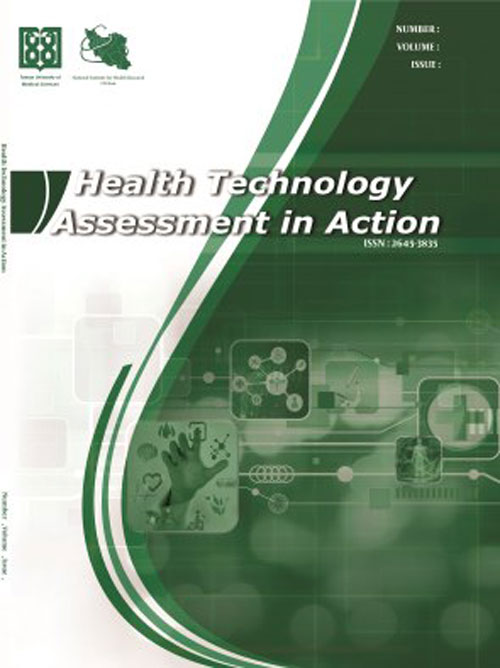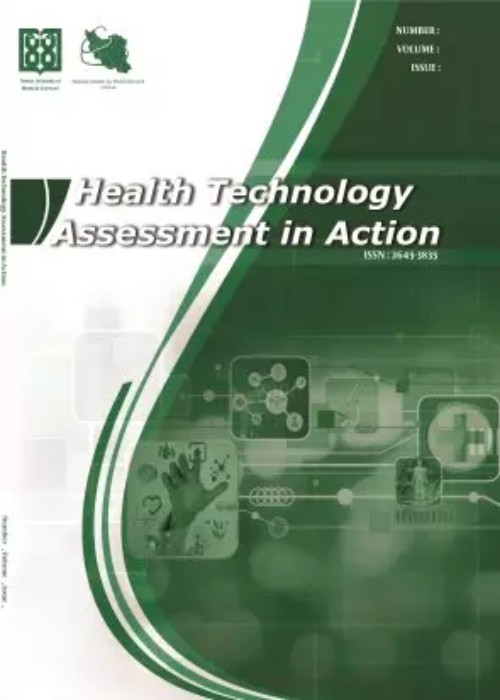فهرست مطالب

Health Technology Assessment in Action
Volume:5 Issue: 3, Jun 2021
- تاریخ انتشار: 1401/01/30
- تعداد عناوین: 8
-
-
Page 84Background
The health sector (health care sector) is considered one of the key sectors in every country and is known as an infrastructure in economic development since the factor directly affects labor productivity and increases production and economic growth. Thus, the health system’s quality may be considered a crucial and attractive factor of foreign direct investment (FDI) along with infrastructures like education, labor, and research and development costs.
ObjectivesThe present study evaluated the short-term and long-term impacts of foreign direct investment on the development of the health sector.
MethodsAccording to the time series data, the ARDL method tests the research hypotheses from 1981 to 2020. The present method can use data of nature I (0) and I (1) simultaneously.
ResultsDuring the years 1982 to 2021 with the increase of foreign capital in the health sector of Iran, health indicators have changed significantly. The rates of some diseases have decreased and in the meantime, the financial resources needed for the health sector have been provided to some extent. According to the coefficients, the highest impact on health expenditures in the short term, foreign directs investment and the lowest impact on the percentage of people living with AIDS.
ConclusionsThe research findings indicate that foreign direct investment has had positive and significant impacts on the development of the health sector in Iran in both the short and long terms.
-
Page 90Introduction
Given the expansion of public-private partnership (PPP) policy in the provision of primary health care to the elderly in different countries, this study aimed to investigate the experiences and achievements of PPP in this field using a scoping review approach.
MethodsThis scoping review study was conducted in 2019 following the Arkesy and O'Malley framework. We systematically searched Google Scholar, a manual search of some journals, references of identified articles, reports and government documents review, web Sites, and other sources of information from January 2000 to October 2019.
ResultsIn total, 10 articles and reports were included, mostly from high-income countries. Twenty-five positive outcomes (12 for the elderly, four for their families, seven for the public sector, and two for the private sector) and three negative outcomes (all for the private sector) were extracted. The most important achievements included improving quality and access to services as well as reducing service costs.
ConclusionThe results show that public-private partnership policy has had many positive results. Therefore, as a major and effective policy, the use of this policy can be considered by policymakers and officials. In this regard, greater support for the private sector and a rigorous and scientific evaluation of this policy's achievements are recommended.
-
Page 109Background
Infertility is an individual and social problem that affects people’s life quality and has been addressed in several scientific fields. Nevertheless, the psychosocial needs of infertile couples during the medical treatment process are discussed to a lesser degree. This study aimed to investigate the efficacy of cognitive-behavioral therapy on depression in infertile women referring to the infertility clinic of Birjand University of Medical Sciences.
MethodsThis quasi-experimental study with a equivalent control group pretest-posttest design was conducted to evaluate the effects of a CBT for 50 women with infertility. The sample consisted of infertile women referring to the university clinic in 2019. The subjects were randomly assigned to control and experimental groups. Beck Depression Inventory was used for data collection. The cognitive-behavioral intervention was conducted during 10 sessions. Data were analyzed in SPSS -19 using statistical tests such as t-test and repeated measures ANOVA.
ResultsIn this study, the mean age of women in the experimental group was 28±4.1 years and 28.04±3.64 years in the control group. There was a significant difference between experimental and control groups in the mean score of depression (P <0.05). Also, the results of the post hoc test showed the stable effect of cognitive-behavioral training on reducing depression in infertile women after the intervention and in the follow-up period.
ConclusionGiven the positive impact of cognitive-behavioral therapy on reducing depression in infertile women, it is suggested that the psychological needs of couples be considered in the medical treatment process.
Keywords: Depression, Cognitive-Behavioral Therapy, Infertile Women -
Page 111Background
This study aimed to investigate the economic evaluation of remote monitoring of type 2 diabetic patients for controlling glycosylated hemoglobin compared to routine care for type 2 diabetics.
MethodsEconomic evaluation was carried out to calculate the unit cost of the remote monitoring technology and the routine treatment for type 2 diabetics, incremental cost-effectiveness ratio, and sensitivity analysis using the key variables such as population size and cost items (in five categories of equipment and devices, building, staff, overhead costs, and consumables costs).
ResultsConsidering the incremental cost-effectiveness ratio in the base-case model and in comparison with routine treatment of type 2 diabetes, remote type 2 diabetes monitoring system was placed in the second quarter (more effective and affordable technology) of the graph as the most dominant alternative (RPM vs. Routine care: Total annual cost difference: -38476.477 US$ / “Unit- reduction in HbA1C” difference: 0.488). The results of the sensitivity analysis revealed that in all scenarios, RPM was dominant compared to the routine treatment (The optimum ICER: -610.128 US$ per “Unit reduction in HbA1C” for the scenario with A 10% increase in the costs of the control and intervention group).
ConclusionRemote patient monitoring is a dominant alternative compared to routine treatment. Results indicated that remote type 2 diabetes monitoring interventions play an effective role in reducing HbA1c, which may be considered the rationale for policymakers to use this technology.
-
Page 112Background
In the event of a crisis and epidemic of an infectious disease, ensuring the proper and timely supply of necessary medicine is one of the main priorities of the health care system in any country. Therefore, the present study investigates the resilience of the Iranian medicine supply chain using the system dynamics simulation method in increasing the level of access to Remdesivir.
Methods and Materials:This is a development-applied study to provide a model using the system dynamics approach, which first presents a rich image that is the based on the model, and then cause-effect models appropriate to the observations made. It was structured on the behavior of the system and also inspired by valid theories. The effect of key factors affecting the supply chain resilience of the country's pharmaceutical industry was designed and analyzed using a system dynamics approach using decision support system (DSS) Vensim software. The time horizon considered for this research was a 5-year period from 2019 to 2023. In order to predict and simulate the system dynamics model, the data collected from the questionnaires and the interviews with experts in this field were used.
ResultsBased on the scenarios presented in this study, it can be expected that by reducing the schedule pressure by 1 and 3% during the time of the study, the resilience of the supply chain of Remedesvir in the country upgraded to about 32% and 47%.
ConclusionAccording to the complexity of health care systems, it is difficult to recognize the interaction of different variables, therefore the effect of interventions is not immediately recognizable and requires the passage of time. In addition, majority of the factors influencing health care outcomes are nonlinear. Therefore, the use of simulation models can help to clarify the indirect behavior of complex health care problems.
-
Page 114Introduction
Considering the importance of healthy lifestyle education in the prevention and control of hypertension and also timely identification of prehypertensive individuals, the present study was conducted to determine the effect of educational intervention based on self-efficacy theory and self-regulatory strategies on physical activity of pre-hypertensive individuals.
Materials and MethodsThis quasi-experimental study was performed on 90 people, aged 30 to 59 years who referred to urban health centers in Nehbandan in 2021. They were randomly selected and divided into two groups of 50 (intervention and control). Data were completed and collected by questionnaires of demographic information, knowledge of hypertension, self-efficacy of physical activity and standard questionnaire of physical activity by self-administered method. After the pre-test, the intervention group received 6 training sessions in 4 weeks. The post-test was performed in two groups immediately and three months after the training sessions. Data were analyzed by repeated measures analysis of variance, Bonferroni post hoc test, independent t-test and Chi-square test in SPSS software version 21.
ResultsIn the present study, the mean age of participants in the control group was 45.80±8.31 and in the intervention group were 44.95 ± 8.20. Data analysis showed the equality of awareness, self-efficacy and physical activity in the two groups before the intervention (p<0.05). After the intervention, a significant increase in the mean and standard deviation of knowledge, self-efficacy and physical activity was observed in the intervention groups immediately and three months after the intervention (p>0.05). Also, the level of awareness, self-efficacy and physical activity in the control group was significantly lower than the intervention group (p>0.001).
ConclusionThe results of the present study showed the effectiveness of educational intervention based on self-efficacy theory and self-regulatory strategies on physical activity of pre-hypertensive individuals. Therefore, the use of this model in the design of educational interventions to promote regular physical activity is recommended.
-
Page 115
Accessing to health goods is one of the essential parts of human rights. Iran has experienced several rounds of economic sanctions in recent decades. As can be seen from past experience, it is obvious that these sanctions affected Iran's financial relations with other countries and banking services and as a result, it had adverse effects on the country's production. Although these sanctions have not directly targeted pharmaceutical products, but due to disruption of financial relations, they have affected widespread issues such as the possibility of importing raw materials, exporting pharmaceutical products, trade cooperation and partnership with foreign partners in the Iranian drug and health technologies market
-
Page 116Background
The budget for universities and training centers should meet all the requirements of that organization. This has led to the need to design an appropriate budgeting policy in the context of economic sanctions in educational institutions, as much as possible. Accordingly, this study was conducted to identify the components of budgeting policy of educational organizations with emphasis on resistance economics.
Methods and Materials:The present study was an applied study that was conducted with a qualitative approach and descriptive phenomenological method. The statistical population was the professors of the Department of Educational Management and Public Administration and the Management of Health Services and the policy makers in the field of education budgeting. Semi-structured interviews were used to collect information. The findings of the interviews were analyzed by content analysis method (open and axial coding).
ResultTotally, nine main themes of financial resource diversification, resistance economics, managerial, human and technical factors, decentralization, transparency, central justice, structural, environmental factors and education budget policy were identified.
ConclusionAccording to the findings, it can be said that the development of a local budgeting model in educational institutions, in spite of being scientific, it will be adapted and implemented according to the climatic, political, social, scientific and cultural conditions of educational institutions.


